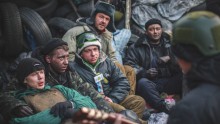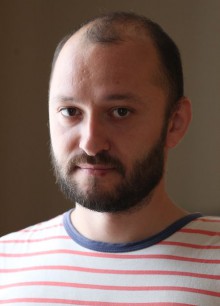Well-known Ukrainian freelance photographer Oleksandr Kuzmin worked a lot in the Maidan past year. Later he went to the ATO area; in particular, he was one of the first photographers who captured the liberation of Sloviansk. Although Oleksandr’s photos often depict the development of dramatic events, they always possess the element of life-assertion and optimism. People while having rest at the Maidan were singing to guitar, hugging, and kissing. “Life was whirling there, and life won after all,” the photographer says. Or the optimistic work Life-Giving Pole, which was awarded at last year’s photo exhibit of Den by the partner of the competition, the Embassy of the Kingdom of Norway to Ukraine. It shows people in liberated Sloviansk who charge their electronic devices from an electric pole.
“In my work there is no purposeful orientation at life-asserting motives. It happens so – catching a tearful smile, or a confident look into the future of a tired protester from one of the sotnias. I try to shoot everything I see and what in my opinion will be interesting for people. The only thing is action is not my genre. I never focus on this subject and never speculate on it,” Oleksandr Kuzmin says. “I’m more interested in the routine life where you can literally ‘grab’ a living detail, an image. Even at the Maidan I focused my attention on the peculiarities of life of the protesters who left their homes, left their comfort zones, to express a public protest. Fortunately, everyday life is not always dramatic. People got acquainted at the Maidan, they fell in love. They sang to guitars, they prepared for a fight together. When you are in the whirl of events, an inner voice tells you – make a photo. Right now.”
What is the story of the Life-Giving Pole?
“This is Sloviansk, practically immediately after liberation. I decided to go there, because I couldn’t but do this. That was a very important event for the country, and I wanted to show the heroes who brought peace to the town. I saw the heroic deeds with my own eyes. The photo you’ve mentioned shows Sloviansk’s central square, not far from the city hall. When we came there, there was no water or light in the town. They only started to restore the electricity. The first objects were the city hall and the electric poles, located on the perimeter. People connected adapters to the pole and came up to it to charge phones, laptops, and other gadgets. This photo is very symbolical for me, because in fact this pole to some extent united the residents of the entire city around the things that were important for them – banally in everyday life. Frankly, I have met in the town people who had a hostile attitude to Ukraine, called to unite with the DNR. But as a result people understood that namely Ukraine secured peace and comfort for them, restored the electricity and water supply. When I look at the photos, I recall my feelings that prompted me to make it – residents of a modern country located in the center of Europe in the 21st century have to charge their devices from poles. This is a surrealistic image.
“The work in such conditions is a new experience for the most of Ukrainian photographers. We automatically got to know the types of armored vests and helmets. We underwent trainings of first aid at war. A part of photographers unwittingly became war journalists. Of course, there were a few people who had shot war abroad. But even they admitted that the war experience in your homeland is a totally different thing. For example, I have never wanted to go to Afghanistan or Iraq. Personally for me it is more important to look with the help of a camera for the answers to the questions that concern Ukrainians the most. The war in Afghanistan, although it was a terrible thing, like any war, and we should write the truth about it, was not close for most of Ukrainians. But today the war has come to our country. This is a dramatic impetus for a degeneration of the nation. And the photographers must capture the processes of the modern history and live them through.”
Past year you for the first time took part in Den’s photo competition and became a winner. What surprise have you prepared this time?
“This year I will take part in the competition only if I am able to select something decent. This year I got a leg trauma, underwent treatment in a hospital, the recovery took a long time, and I have missed many events. I respect your photo competition very much, not to submit some second-rate material. I should admit, this is the first competition, where I have dared to take part. The first one didn’t take place at all. Therefore this is a kind of a start for me. On the one hand, I don’t look for recognition, but on the other hand this is a unique opportunity for the photographers to show themselves and their works.
“In Ukraine Den’s photo competition is the most influential and large-scale. It is the patriarch among this type of competitions. It is good when photos are published in the press. But the competition of Den’s scale is a totally different level of perception of our works. This is an opportunity to show to the mass thinking audience what you do, think, and feel. After all, this is a forum of communication for all the photo correspondents of the country. Of course, we know one another, meet at the shooting. But to come to Den’s exhibit, to see many people you haven’t seen for a while, to see what they have done in year’s time, to show some works of yours… this gives you an incredible feeling of drive.”








